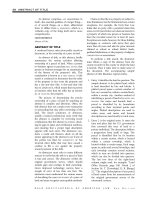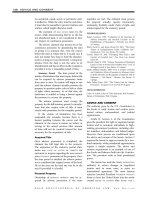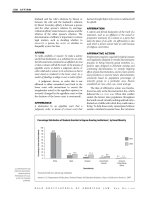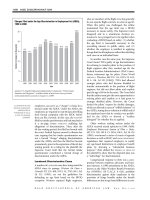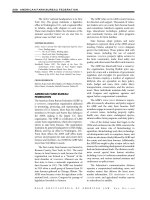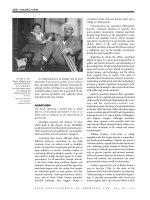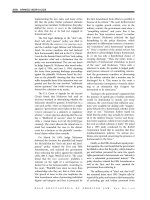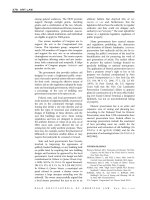Gale Encyclopedia Of American Law 3Rd Edition Volume 11 P18 ppt
Bạn đang xem bản rút gọn của tài liệu. Xem và tải ngay bản đầy đủ của tài liệu tại đây (123.57 KB, 10 trang )
which it must give a measure of consideration,
may be freely admitted. But its solution cannot
be promoted by depriving citizens of their
constitutional rights and privileges.
We believe the same answer should be given
to any suggestion that the enforcement of con-
stitutional rights be deferred to a time when it
will have uniform public acceptance.
Even if relevant, results of polls are often
not conclusive. For example, the Florida survey
polled eleven “leadership” groups. These groups
give evidence of a very high degree of “willing-
ness” to comply. Although peace officers are
greatly opposed to desegregation (Table 3, p.
138), only two of the eleven groups would not
positively comply, and in those cases there is a
very even division (Table 4, p. 139). Overall, six
of the eleven groups are not opposed to the
decision (Table 3, p. 138); 84.5% of white
principals and supervisors who, would be
charged with the duty of implementation,
would comply (Table 4, p. 139). A majority of
all groups expect neither mob violence nor
“serious violence” (Table 5, p. 140).
Moreover, such polls are not a valid index of
how the individuals questioned will in fact act
in the event of desegregation. Modern psycho-
logical research shows that, especially in the case
of broad public issues, many persons simply “do
not follow through even on actions which they
say they personally will take in support of an
opinion.”
15
The Attorney General of Texas sets out in
his br ief in these cases a survey by the “Texas
Poll” showing 71% disapproval of the May 17th
decision and 65% approval of continued
segregation notwithstanding this Court’s deci-
sion. It is interesting to note that in Sweatt v.
Painter, 339 U.S. 629, respondents included in
their brief a survey made by the same “Texas
Poll” showing that 76% of all Texans were
“against Negroes and whites going to the same
universities.” However, this Court ordered
Sweatt admitted to the University of Texas. He
and other Negroe s attended the University.
16
Since then Negroes have been admitted to and
are attending this and other public universities
in twelve southern States.
16a
Finally, there is nothing to indicate that an
extended delay in ordering the elimination of all
segregation will improve public attitudes or
eliminate the objections presently interposed.
Clearly the polls are irrelevant and should be so
treated by this Court.
The wide applicability of the decision in
these cases should not affect the relief to
which appellants are entitled Effort is made
throughout the briefs for appellees and the
several attorneys general to balance the personal
and present rights here involved against the
large number of children of both races now
attending public school on a segregated basis.
This argument is made for a twofold purpose:
to escape the uniformity of decisions of this
Court on the personal character of the rights
involved and, secondly, to destroy the present
character of the right involved.
Of course, the decision of this Court in the
instant cases will have wide effect involving
public school systems of many states and many
public school children. The mere fact of numbers
involved is not sufficient to delay enforcement of
rights of the type here involved.
17
15
BUCHANAN, KRUGMAN AND VAN WAGENEN, AN INTERNATIONAL
POLICE FORCE AND PUBLIC OPINION
13 (1954). For other studies
dealing with the discrepancy between verbal statements and
actions, see Link and Freiberg, “
THE PROBLEM OF VALIDITY VS.
RELIABILITY IN PUBLIC OPINION POLLS”,6PUBLIC OPINION QUARTERLY
87–98,esp.91–92 (1942); JENKINS AND CORBIN, “DEPENDABILITY OF
PSYCHOLOGICAL BRAND BAROMETERS II
, THE PROBLEM OF VALIDITY”,22
JOURNAL OF APPLIED PSYCHOLOGY,252–260 (1938); HYMAN, “DO
THEY TELL THE TRUTH
?”,8PUBLIC OPINION QUARTERLY 557–559
(1944);
SOCIAL SCIENCE RESEARCH COUNCIL, COMMITTEE ON ANALYSIS
OF PRE
–ELECTION POLLS AND FORECASTS 302–303 (1949); LA PIERE,
“
ATTITUDES VS. ACTIONS”,13SOCIAL FORCES 230–237 (1934); DOOB,
PUBLIC OPINION AND PROPAGANDA 151(1948);HARTLEY AND HARTLEY,
FUNDAMENTALS OF SOCIAL PSYCHOLOGY 657 (1952). See also Irvin v.
State, 66 So. 2d 288, 290–292, cert. denied 346 U.S. 927, reh.
denied 347 U.S. 914.
16
It is also significant that many municipal junior colleges in
Texas have also desegregated their student bodies. See
SOUTHERN SCHOOL NEWS, October 1, 1954, p. 13, c. 5.
16a
JOHNSON, “PUBLIC HIGHER EDUCATION IN THE SOUTH”,23JOURNAL
OF NEGRO EDUCATION
317 (1954), especially at 328 where Dr.
Johnson, University of North Carolina Sociologist, concludes:
The transition from complete segregation to some
degree of integration of Negroes into the publicly-
supported institutions of higher learning in the
South has already been accomplished in all except
five of the Southern states, and most of this change
has occurred in the brief period, 1948–1953.
Despite numerous predictions of violence, this
transition has been accomplished without a single
serious incident of interracial friction.
17
We put to one side as obviously immaterial the mere
technical character of these suits as class actions under Rule
23(a)(3). Obviously, the mere joinder of plaintiffs in a
spurious class suit for reasons of convenience cannot have
any effect on the nature of the rights asserted or on the
availability of normal relief remedy. Whether a suit is or is
not a class action tells us little, in this field of law, as to the
magnitude of the interests involved; Sweatt v. Painter was an
individual mandamus suit, but the effect of that decision
spread throughout the segregating states.
MILESTONES IN THE LAW BROWN V. BOARD OF EDUCATION 157
U.S. SUPREME
COURT,
OCTOBER 1954
REPLY BRIEF FOR
APPELLANTS
AND
RESPONDENTS
ON FURTHER
REARGUMENT
GALE ENCYCLOPEDIA OF AMERICAN LAW, 3RD E DITION
On the face of it, their position is both ill-
taken and self-defeating. That it is ill-taken
becomes clear when the suggestion itself is
clearly stated; obviously, there is nothing in mere
numerousness as such which has any tendency
whatever to create or destroy rights to efficacious
legal relief. Behind every numeral is a Negro
child, suffering the effects spoken of by the Court
on May 17. It is a manifest inconsequence to say
that the rights or remedial needs of each child are
diminished merely because others are in the
same position. That this argument is self-
defeating emerges when it is considered that its
tendency is simply to establish that we have to do
with an evil affecting a great many people;
presumably, the abolition of a widespread evil is
even more urgent than dealing with isolated
cases of wrongdoing.
This Court has consistently treated the
personal rights of litigants on a personal basis.
Every leading case involving discrimination
against Negroes has necessarily and demonstra-
bly involved large numbers of people; yet this
Court has given present relief on a personal basis
to those who showed themselves entitled to it,
without any hint of the possibility that the rights
of citizenship are diminished because many
people are being denied them. The Sweatt, Sipuel
and McLaurin cases and Sm ith v. Allwright, all, as
was well known to this Court and to the country,
involved not merely the individuals or class-
plaintiffs or geographical subdivision actually
before the Court, but also the whole framework
of law school, graduate school or primary
election segregation. All major constitutional
cases involve large numbers of people. Yet there
is not a hint, in words or in action, in any past
case, to the effect that the w ide applicability of a
decision was considered material to the right to
relief. It is unthinkable that this Court would
apply any such doctrine to limit the enjoyment
of constitutional rights in general; there is no
reason for its making a special and anomalous
exception of the case at bar.
Actually, to point to the vast numbers of
people whose lives will be affected by the relief
granted here is only a diffuse way of raising all
the questions as to the consequences of immedi-
ate desegregation. We have dealt with these
questions elsewhere. The suggestion that mere
numerousness makes a difference adds nothing
new, but merely serves to confuse the issues by
diverting attention from the extremely personal
plight of each child, and from his need for
present relief.
Average differences in student groups have
no relevance to the individual rights of pupils:
individual differences can be handled admi-
nistratively without reference to race Having
attempted to subordinate appellants’ personal
and present constitutional rights to an alleged
overriding consideration of the large numbers
of peop le involved, these briefs for appellees
then seek to further limit the individual rights of
Negro students by broad characterizations of
group intelligence, group morality and health.
18
Specifically, it is pointed out that statistics show
that on the average Negro children in segregated
schools score lower on achievement tests and
are in general more retarded culturally than white
children. This data, contrary to the conclusions
advanced thereupon, merely underscores and
further documents the finding quoted in this
Court’s opinion:
“Segregation of white and colored children in
public schools has a detrimental effect upon
the colored children. The impact is greater
when it has the sanction of the law; for the
policy of separating the races is usually
interpreted as denoting the inferiority of
the Negro group. A sense of inferiority affects
the motivation of a child to learn. Segrega-
tion with the sanction of law, therefore, has
a tendency to [retard] the educational and
mental development of Negro children and
to deprive them of some of the benefits they
would receive in a racial[ly] integrated school
system.”
We have come too far not to realize that
educability and absorption and adoption of
cultural values has nothing to do with race.
What is achieved educationally and culturally,
we now know to be largely the result of
opportunity and environment.
19
That the Negro
is so disadvantaged educationally and culturally
in the states where segregation is required is
the strongest argument against its continuation
for any period of time. Yet those who use this
argument as a basis for interminable delay in
18
North Carolina Brief, pp. 39–41; Florida Brief, pp. 19–21,
189.
19
KLINEBERG, RACE DIFFERENCES: THE PRESENT POSITION OF THE
PROBLEM
,2INTERNATIONAL SOCIAL SCIENCE BULLETIN 460 (1950);
MONTAGUE, STATEMENT ON RACE, THE UNESCO STATEMENT BY
EXPERTS ON RACE PROBLEMS
14–15 (1951); MONTAGUE, MAN’S
MOST DANGEROUS MYTH
: THE FALLACY OF RACE 286 (1952);
KIRKPATRICK, PHILOSOPHY OF EDUCATION 399–433 (1951). See
KLINEBERG, RACE AND PSYCHOLOGY, UNESCO (1951); ALLPORT, THE
NATURE OF PREJUDICE
(1954); COMAS, RACIAL MYTHS, UNESCO
(1951).
158 BROWN V. BOARD OF EDUCATION MILESTONES IN THE LAW
U.S. SUPREME
COURT,
OCTOBER 1954
REPLY BRIEF FOR
APPELLANTS
AND
RESPONDENTS
ON FURTHER
REARGUMENT
GALE ENCYCLOPEDIA OF AMERICAN LAW, 3RD E DITION
the elimination of segregation in reality are
seeking to utilize the product of their own
wrongdoing as a justification for continued
malfeasance.
Our public school systems have grown and
improved as an American institution. And in
every community it is obvious that children of all
levels of culture, educability, and achievement
must be accounted for within the same system.
In some school systems the exceptional children
are separated from the rest of the children. In
others there are special classes for retarded
children, for slow readers and for the physically
handicapped. But these factors have no relation
to race. These are administrative problems with
respect to conduct of the public school.
In the past, large city school systems, North
and South, have had the problem of absorbing
children from rural areas where the public
schools and cultural backgrounds were below
the city standards. On many occasions these
migrations have been very sudde n and in
proportionately very large numbers. This prob-
lem has always been solve d as an administrative
detail. It has never been either insurmountable
nor has it been use d as an excuse to force the
rural children to attend sub-standard schools.
Similarly, large cities have met without difficulty
the influx of immigrants from foreign countries.
Cultural and health standards have always
been maintained in public schools and there
could be no objection to the continuation of
such standards without regard to race. All social
scientists seem to be in agreement that race
and color have no connection whatsoever with
a student’s ability to be educated. Achievement
and cultural deficiencies are nonracial in char-
acter, also. Hence these factors in no wise relate
to questions posed as to whether desegregation
should take place immediately or over an
extended period.
Perhaps the main reasons for rejecting
appellees’ argument are that the conditions they
complain of can never be remedied as long as
segregation in public schools is continued and
these so-called problems, i.e., average on achie-
vement tests, health, etc., are administrative
problems which can be solved by recognized
administrative regulations made to fit the pro-
blems without regard to pigmentation of the skin.
It is significant that appellees and the Attorneys-
General who advance these arguments do not
give any hope to anyone that the continuation
of segregated public education will ever remove
these problems which are the product of this
segregation.
On the other hand, appellants have shown
in their Brief on Further Reargument that on
the basis of substantial documented experience:
“There is no basis for the assumption that
gradual as opposed to immediate desegregation
is the better, smoother or more ‘effective’ mode
of transition. On the contrary, there is an
impressive body of evidence which supports the
position that gradualism, far from facilitating
the process, may actually make it more difficult;
that, in fact, the problems of transition will be
a good deal less complicated than might be
forecast by appellees. Our submission is that
this, like many wrongs, can be easiest and best
undone, not by ‘tapering off’ but by forthright
action” (p. 31).
Official reactions in states affected by the
May 17th decision make it plain that delay
will detract from rather than contribute to the
“effectiveness” of the transition to desegre-
gated schools Events occurring in the states
affected by the decision of May 17, 1954, do not
support the suggestions of appelle es and amici
curiae that further (and limitless) postponement
of relief to Negro children will assure an
“effective” adjustment from segregated to non-
segregated school systems. In terms of legisla-
tive, executive or administrative reaction, the
southern and border states may now be grouped
in three loose categories:
(1) Those which have not waited for further
directions from the Court, but have undertaken
desegregation in varied measure during the
current school year. Typical of the states falling
in this category are Delaware,
20
Kansas,
21
Mis-
souri,
22
and West Virginia.
23
Although not a
20
Brief for Appellants in Nos. 1, 2 and 3 and for
Respondents in No. 5 on Further Reargument, pp. 4–7;
Brief for Petitioners on the Mandate in No. 5, pp. 10–12.
21
Brief for Appellants in Nos. 1, 2 and 3 and for
Respondents in No. 5 on Further Reargument, pp. 3–4;
Supplemental Brief for the State of Kansas on Questions 4
and 5 Propounded by the Court, pp. 13–22; Supplemental
Brief for the Board of Education, Topeka, Kansas on
Questions 4 and 5 Propounded by the Court, pp. 2–4.
22
SOUTHERN SCHOOL NEWS, September 3, 1954, p. 9, c. 2–5; Id.,
October 1, 1954, p. 10, c. 1–5; Id., November 4, 1954, p. 12,
c. 1–5; Id., December 1, 1954, p. 10, c. 1–5; Id., January 6,
1955, p. 11, c. 1; Id., February 3, 1955, p. 15, c. 1–5.
23
SOUTHERN SCHOOL NEWS, October 1, p. 14, c. 1, 5; Id.,
January 6, 1955, p. 2, c. 4–5.
MILESTONES IN THE LAW BROWN V. BOARD OF EDUCATION 159
U.S. SUPREME
COURT,
OCTOBER 1954
REPLY BRIEF FOR
APPELLANTS
AND
RESPONDENTS
ON FURTHER
REARGUMENT
GALE ENCYCLOPEDIA OF AMERICAN LAW, 3RD E DITION
state, the District of Columbia would fall within
this group.
(2) Those w hich have decided to await a
decision on the question of relief but have
indicated an intention to obey the Court’s
directions. Kentucky,
24
Oklahoma,
25
and Ten-
nessee
26
are among the states in this category.
(3) Those which have indicated an intention
to circumvent the decision of this Court or
interminably delay the enjoyment by Negro
children of their constitutionally protected
rights not to be segregated in public schools.
Included in this category are states like South
Carolina
27
and Mississippi,
28
which have enacted
legislation designed to nullify any decision of this
Court in these cases, and states like Virginia
29
and Florida,
30
where either the governors or
special legislative committees studying the prob-
lem have recommended that “every legal means”
be used to preserve segregated school systems.
31
Against this background of state reaction to
the decision of May 17, 1954, it is clear that
postponement of relief will serve no purpose.
The states in the first category have already
begun to implement this Court’s decision and
any delay as to them may imperil the progress
already made.
32
The states in the second category
have indicated a willingness to do whatever this
Court directs and there is certainly no reason
for delay as to them. The probable effect of
delay, as to states in the third category, must be
evaluated in the light of their declared inten-
tions; we are justified in assuming that it would
have no affirmative effect, but would merely
provide additional time to devise and put into
practice schemes expressly designed to thwart
this Court’s decision.
CONCLUSION
Appellants recognize that the problems con-
fronting this Court, as it turns to the
implementation of its decision in these cases,
are of primary magnitude. Their high serious-
ness is enhanced by the fact that sovereign states
are in effect, though not formally, at the bar and
that the evil to which the Court’s decree must
be directed is no transitory wrong but is of the
essence of the social structure of a great section
of our nation.
Yet, it should be borne in mind that the very
magnitude of these problems exists because of
the assumption, tacitly indulged up to now, that
the Constitution is not to be applied in its full
force and scope to all sections of this country
alike, but rather that its guarantees are to be
enjoyed, in one part of our nation, only as
molded and modified by the desire and customs
of the dominant component of the sectional
population. Such a view, however expressed,
ignores the minimum requirement for a truly
national constitution. It ignores also a vast part
of the reality of the sectional interest involved,
for that interest must be composed of the
legitimate aspirations of Negroes as well as
whites. It certainly ignores the repercussions
which any reluctance to forthrightly enforce
appellants’ rights would have on this nation’s
international relations. Every day of delay
means that this country is failing to develop
its full strength.
The time has come to end the division of
one nation into those sections where the
Constitution is and those where it is not fully
respected. Only by forthright action can the
country set on the road to a uniform amenabil-
ity to its Constitution. Finally, the right asserted
by these appellants is not the only one at stake.
The fate of other great constitutional freedoms,
whether secured by the Fourteenth Amendment
or by other provisions, is inevitably bound up in
the resolution to be made in these cases. For
24
SOUTHERN SCHOOL NEWS, September 3, 1954, p. 7, c. 3; Id.,
November 4, 1954, p. 16, c. 1; Id., December 1, 1954, p. 9,
c. 1, 3.
25
SOUTHERN SCHOOL NEWS, February 3, 1955, p. 10, c. 1–2; Id.,
March 3, 1955, p. 16, c. 1;
THE NEW YORK TIMES, April 6, 1955,
p. 20, c. 5.
26
SOUTHERN SCHOOL NEWS, October 1, 1954, p. 11, c. 1; Id.,
December 1, 1954, p. 12, c. 4;
NEW YORK POST, March 16,
1955, p. 58, c. 4.
27
SOUTHERN SCHOOL NEWS, September 3, 1954, p. 12, c. 1–2; Id.,
February 3, 1955, p. 3, c. 2–4, Id., March 3, 1955, p. 14, c. 1–3.
28
SOUTHERN SCHOOL NEWS, September 3, 1954, p. 8, c. 3; Id.,
October 1, 1954, p. 9, c. 4–5; Id., November 4, 1954, p. 11, c.
4–5; Id., January 6, 1955, p. 10, c. 1–2; THE NEW YORK TIMES,
April 6, 1955, p. 20, c. 5.
29
SOUTHERN SCHOOL NEWS, February 3, 1955, p. 10, c. 4.
30
SOUTHERN SCHOOL NEWS, January 6, 1955, p. 6, c. 2.
31
Indeed, Governor Marvin B. Griffin of Georgia has
asserted: “However, if this court is so unrealistic as to
attempt to enforce this unthinkable evil upon us, I serve
notice now that we shall resist it with all the resources at our
disposal and we shall never submit to the proposition of
mixing the races in the classrooms of our schools.”
32
See, e.g., Steiner v. Simmons, 111 A. 2d 574 (Del. 1955), rev’g.
108 A. 2d 173 (Del. 1954). There the Supreme Court reversed a
chancery court determination that forthwith desegregationwas
proper under the decision of this Court of May 17, 1954.
160 BROWN V. BOARD OF EDUCATION MILESTONES IN THE LAW
U.S. SUPREME
COURT,
OCTOBER 1954
REPLY BRIEF FOR
APPELLANTS
AND
RESPONDENTS
ON FURTHER
REARGUMENT
GALE ENCYCLOPEDIA OF AMERICAN LAW, 3RD E DITION
delay in enforcement of these rights invites the
insidious prospect that a moratorium may
equally be placed on the enjoyment of other
constitutional rights.
In disposing of the great issues before it, this
Court should do no less than order the abolition
of racial segregation in public education by a
day certain, as heretofore set forth in Appel-
lants’ Brief on Further Reargument.
Respectively submitted,
CHARLES L. BLACK JR.,
ELWOOD H. CHISOLM,
WILLIAM T. COLEMAN JR.,
CHARLES T. DUNCAN,
GEORGE E. C. HAYES,
LOREN MILLER,
WILLIAM R. MING JR.,
CONSTANCE BAKER MOTLEY,
JAMES M. NABRIT JR.,
LOUIS H. POLLAK,
FRANK D. REEVES,
JOHN SCOTT,
JACK B. WEINSTEIN, of Counsel.
HAROLD BOULWARE,
ROBERT L. CARTER,
JACK GREENBERG,
OLIVER W. HILL,
THURGOOD MARSHALL,
LOUIS L. REDDING,
SPOTTSWOOD W. ROBINSON III,
CHARLES S. SCOTT, Attorneys for Appellants in
Nos. 1, 2, 3 and for Respondents in No. 5.
MILESTONES IN THE LAW BROWN V. BOARD OF EDUCATION 161
U.S. SUPREME
COURT,
OCTOBER 1954
REPLY BRIEF FOR
APPELLANTS
AND
RESPONDENTS
ON FURTHER
REARGUMENT
GALE ENCYCLOPEDIA OF AMERICAN LAW, 3RD E DITION
IntheSupremeCourtof
the United States
Cite as 75 S.Ct. 753
k
OLIVER BROWN, ET AL., APPELLANTS,
V.
BOARD OF EDUCATION OF TOPEKA,
SHAWNEE COUNTY, KANSAS, ET AL.
HARRY BRIGGS, JR., ET AL.,
APPELLANTS,
V.
R. W. ELLIOTT, ET AL.
DOROTHY E. DAVIS, ET AL.,
APPELLANTS,
V.
COUNTY SCHOOL BOARD OF PRINCE
EDWARD COUNTY, VIRGINIA,
ET. AL.
SPOTTSWOOD THOMAS BOLLING, ET AL.,
PETITIONERS,
V.
C. MELVIN SHARPE, ET AL.
FRANCIS B. GEBHART, ET AL.,
PETITIONERS,
V.
ETHEL LOUISE BELTON, ET AL.
Nos. 1–5.
Argued April 11, 12, 13, and 14, 1955.
Decided May 31. 1955.
349 U.S. 294
Class actions by which minor plaintiffs
sought to obtain admission to public schools
on a nonsegregated basis. On direct appeals by
plaintiffs from adverse decisions in United
States District Courts, District of Kansas, 98 F.
Supp. 797, Easter n District of South Carolina,
103 F.Supp. 920, and Eastern District of
Virginia, 103 F.Supp. 337, on certiorari before
judgment on appeal to the United States Court
of Appeals for the District of Columbia from
adverse decision in the United States District
Court for the District of Columbia, and on
certiorari from decision favorable to plaintiffs in
the Supreme Court of Delaware, 91 A.2d 137,
the Supreme Court, 347 U.S. 483, 74 S.Ct. 686,
98 L.Ed. 873, and 347 U.S. 497, 74 S.Ct. 693, 98
L.Ed. 884, held that racial discrimination in
public education was unconstitutional and
restored cases to dock et for further argument
regarding formulation of decrees. On further
argument, the Supreme Court, Mr. Chief Justice
Warren, held that in proceedings to implement
Supreme Court’s determination, inferior courts
might consider problems related to administra-
tion, arising from physical condition of school
plant, school transportation system, personnel,
revision of school districts and attendance areas
into compact units to achieve system of
determining admission to public schools on a
nonracial basis, and revision of local laws and
regulations, and might consider adequacy of any
plan school authorities might propose to meet
these problems and to effectuate a transition to
racially nondiscriminatory school systems.
Judgments, except that in case No. 5,
reversed and cases remanded with directions;
judgment in case No. 5 affirmed and case
remanded with directions.
All provisions of federal, state, or local law
requiring or permitting racial discrimination in
public education must yield to principle that
such discrimination is unconstitutional. U.S.C.A.
Const. Amend.
School authorities have primary responsi-
bility for elucidating, asses sing, and solving
problems arising from fact that racial discrimi-
nation in public education is unconstitutional.
Question whether school authorities’ actions
constitute good faith implementation of princi-
ple that racial discrimination in public education
is unconstitutional could best be appraised by
courts which originally heard cases raising
questions of constitutionality of such discrimi-
nation, and it was appropriate to remand cases to
such courts. 28 U.S.C.A.§§ 2281, 2284.
Traditionally, equity has been characterized
by a practical flexibility in shaping its remedies
and by a facility for adjusting and reconciling
public and private needs.
Courts of equity, in implementing Supreme
Court’s determination that racial discr imination
in public education is unconstitutional, may
properly take into account the public interest
in elimination, in a systematic and effective
manner, of obstacles to transition to school
systems operated in accordance with constitu-
tional principles, but constitutional principles
cannot be allowed to yield because of disagree-
ment with them.
162 BROWN V. BOARD OF EDUCATION MILESTONES IN THE LAW
U.S. SUPREME
COURT, 1955
GALE ENCYCLOPEDIA OF AMERICAN LAW, 3RD E DITION
On remand from Supreme Court after
determination in several cases that racial dis-
crimination in public education is unconstitu-
tional. inferior courts shou ld, while giving
weight to public considerations and private
interest of litigants, require that school authori-
ties make prompt and reasonable start toward
full compliance with ruling.
In proceedings to implement Supreme
Court’s decision that racial discrimination in
public education is unconstitutional, public
school authorities have burden of establishing
that grant of additional time for transition is
necessary in public interest and is consistent with
good faith compliance at earliest practicable date.
Inferior courts, in implementing Supreme
Court’s determination that racial discrimination
in public education is unconstitutional, may
consider problems related to administration,
arising from physical condition of school plant,
school transportation system, personnel, revi-
sion of school districts and attendance areas
into compact units to achieve system of deter-
mining admission to public schools on a
nonracial basis, and revision of local laws and
regulations, and many consider adequacy of any
plans school authorities may propose to meet
these problems and to effectuate a transition to
racially non discriminatory school system.
Inferior courts, on remand from Supreme
Court’s d eter mination that discrimination in
public education is unconstitutional, were directed
to retain jurisdiction of cases during period of
transition t o non discriminat ory s chool systems.
Mr. Robert L. Carter, New York City, for
appellants in No. 1.
Mr. Harold R. Fatzer, Topeka, Kan., for
appellees in No. 1.
Messrs. Thurgood Marshall, New York City,
and Spottswood W. Robinson, III, Richmond,
VA., for appellants in Nos. 2 and 3.
Messrs. S. E. Rogers, Summerton, S. C., and
Robert McC. Figg, Jr., Charleston, S.C., for
appellees in No. 2.
Messrs. Archibald G. Robertson, Richmond,
Va., and J. Lindsay Almond, Jr., Atty. Gen., for
appellees in No. 3.
Messrs. George E. C. Hayes and James M.
Nabrit, Jr., Washington, D.C., for petitioners in
No. 4.
Mr. Milton D. Korman, Washington, D.C.,
for respondents in No. 4.
Mr. Joseph Donald Craven, Wilmington,
Del., for petitioners in No. 5.
Mr. Louis L. Redding, Wilmington. Del., for
respondents in No. 5.
Messrs. Richard W. Ervin and Ralph E.
Odum, Tallahassee. Fla., for State of Florida,
I. Beverly Lake, Raleigh, N.C., for State of North
Carolina, Thomas J. Gentry, Little Rock, Ark.,
for State of Arkansas, Mac Q. Williamson
Oklahoma, City, Okla., for State of Oklahoma,
C. Ferdinand Sybert, Ellicott City, Md., for State
of Maryland, John Ben Shepperd and Burnell
Waldrep, Austin, Tex., for State of Texas, Sol.
Gen. Simon E. Sobeloff, Washington, D.C., for
United States, amici curiae.
Mr. Chief Justice Warren delivered the
opinion of the Court.
[1] These cases were decided on May 17,
1954. The opinions of that date,
1
declaring the
fundamental principle that racial discrimination
in public education is unconstitutional, are
incorporated herein by reference. All provisions
of federal, state, or local law requiring or
permitting such discrimination must yield to
this principle. There remains for consideration
the manner in which relief is to be accorded.
Because these cases arose under different
local conditions and their disposition will
involve a variety of local problems, we requested
further argument on the question of relief.
2
In
view of the nationwide importance of the
decision. we invited the Attorney General of
1
347 U.S. 43, 74 S.Ct. 686, 98 L.Ed. 873, 347 U.S. 497, 74 S.
Ct. 693, 98 L.Ed. 884.
2
Further argument was requested on the following ques-
tions, 347 U.S. 483, 495–496, note 13, 74 S.Ct. 686, 692, 98
L.Ed. 873, previously propounded by the Court:
“4. Assuming it is decided that segregation in public schools
violates the Fourteenth Amendment
“(a) would a decree necessarily follow providing that, within
the limits set by normal geographic school districting, Negro
children should forthwith be admitted to schools of their
choice, or
“(b) may this Court, in the exercise of its equity powers,
permit an effective gradual adjustment to be brought about
from existing segregated systems to a system not based color
distinctions?
“5. On the assumption on which questions 4 (a) and (b) are
based, and assuming further that this Court will exercise its
equity powers to the end described in question 4 (b),
GALE ENCYCLOPEDIA OF AMERICAN LAW, 3RD E DITION
MILESTONES IN THE LAW BROWN V. BOARD OF EDUCATION 163
U.S. SUPREME
COURT, 1955
the United States and the Attorneys General of
all states requiring or permitting racial discrim-
ination in public education to present their
views on that question. The parties, the United
States, and the States of Florida, North Carolina,
Arkansas, Oklahoma, Maryland, and Texas filed
briefs and participated in the oral argument.
These presentations were informative and
helpful to the Court in its consideration of the
complexities arising from the transition to a
system of public education freed of racial
discrimination. The presentations also demon-
strated that substantial steps to eliminate racial
discrimination in public schools have already
been taken, not only in some of the communi-
ties in which these cases arose, but in some of
the states appearing as amici curiae, and in other
states as well. Substantial progress has been
made in the District of Columbia and in the
communities in Kansas and Delaware involved
in this litigation. The defendants in the cases
coming to us from South Carolina and Virginia
are awaiting the decisions of this Court
concerning relief.
[2,3] Full implementation of these constitu-
tional principles may require solution of varied
local school problems. School authorities have
the primary responsibility of elucidating, asses-
sing, and solving these problems; courts will
have to consider whether the action of school
authorities constitutes good faith implementa-
tion of the governing constitutional principles.
Because of their proximity to local conditions
and the possible need for further hearings, the
courts which originally heard these cases can
best perform this judicial appraisal. Accord-
ingly, we believe it appropriate to remand the
cases to those courts.
3
[4,5] In fashioning and effectuating the
decrees, the courts will be guided by equitable
principles. Traditionally, equity has been
characterized by a practical flexibility in shaping
its remedies
4
and by a facility for adjusting and
reconciling public and private needs.
5
These
cases call for the exercise of these traditional
attributes of equity power. At stake is the
personal interest of the plaintiffs in admission
to public schools as soon as practicable on a
nondiscriminatory basis. To effectuate this
interest may call for elimination of a variety of
obstacles in marking the trans ition to school
systems operated in accordance with the
constitutional principles set forth in our May
17, 1954, decision. Courts of equity may
properly take into account the public interest
in the elimination of such obstacles in a
systematic and effective manner. But it should
go without saying that the vitality of these
constitutional principles cannot be al lowed to
yield simply because of disagreement with them.
[6–9] While giving weight to these public
and private considerations, the courts will
require that the defendants make a prompt
and reasonable start toward full compliance
with our May 17, 1954, ruling. Once such a start
has been made, the courts may find that
additional time is necessary to carry out the
ruling in an effective manner. The burden rests
upon the defendants to establish that such time
is necessary in the public interest and is
consistent with good faith compl iance at the
earliest pra cticable date. To that end, the courts
may consider problems related to administra-
tion, arising from the physical condition of the
school plant, the school transportation system,
personnel, revision of school districts and
attendance areas into compact units to achieve
a system of determining admission to the public
schools on a nonracial basis, and revision of
local laws and regulations which may be
necessary in solving the foregoing problems.
They will also consider the adequacy of any
plans the defendants may propose to meet these
problems and to effectuate a transition to a
racially nondiscriminatory school system.
“(a) should this Court formulate detailed decrees in these
cases;
“(b) if so, what specific issues should the decrees;
“(c) should this Court appoint a special master to hear
evidence with a view to recommending specific terms for
such decrees;
“(d) should this Court remand to the courts of first instance
with directions to frame decrees in these cases, and if so
what general directions should the decrees of this Court
include and what procedures should the courts of first
instance follow in arriving at the specific terms of more
detailed decrees?”
3
The cases coming to us from Kansas, South Carolina, and
Virginia were originally heard by three-judge District Courts
convened under 28 U.S.C. §§ 2281 and 2284, 28 U.S.C.A. §§
2281, 2284. These cases will accordingly be remanded to
those three-judge courts. See Briggs v. Elliott, 342 U.S. 350,
72 S.Ct. 327, 96 L.Ed. 392.
4
See Alexander v. Hillman, 296 U.S. 222, 239, 56 S.Ct. 204,
209, 80 L.Ed. 192.
5
See Hecht Co, v, Bowles, 321 U.S. 321, 329–330, 64 S.Ct.
587, 591, 592, 88 L.Ed. 754.
GALE ENCYCLOPEDIA OF AMERICAN LAW, 3RD E DITION
164 BROWN V. BOARD OF EDUCATION MILESTONES IN THE LAW
U.S. SUPREME
COURT, 1955
During this period of transition, the courts will
retain jurisdiction of these cases.
The judgments below, except that in the
Delaware case, are accordingly reversed and the
cases are remanded to the District Courts to
take such proceedings and ente r such orders
and decrees consistent with this opinion as are
necessary and proper to admit to public schools
on a racially nondiscriminatory basis with all
deliberate speed the parties to these cases. The
judgment in the Delaware case—ordering the
immediate admission of the plaintiffs to schools
previously attended only by white children—is
affirmed on the basis of the principles stated
in our May 17, 1954, opinion, but the case is
remanded to the Supreme Court of Delaware
for such further proceedings as that Court may
deem necessary in light of this opinion.
It is so ordered.
Judgments, except that in case No. 5,
reversed and cases remanded with directions;
judgment in case No. 5 affirmed and case
remanded with directions.
GALE ENCYCLOPEDIA OF AMERICAN LAW, 3RD E DITION
MILESTONES IN THE LAW BROWN V. BOARD OF EDUCATION 165
U.S. SUPREME
COURT, 1955
